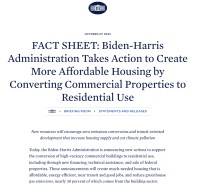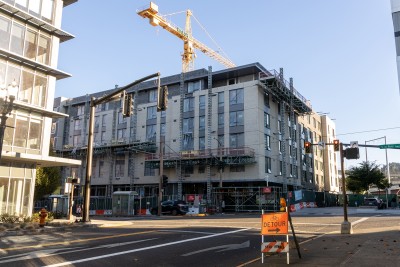By Mary Kyle McCurdy | 2.5-minute read
Oregon’s ability to convert underutilized commercial buildings for residential use just got a boost thanks to the Biden administration’s recent announcement of funding and programs for this purpose, including through “new financing, technical assistance, and sale of federal properties.” Key legislation and agency programs have positioned Oregon to use this funding to create thousands of new homes well-located in our existing towns and cities – a strong fit for the funding that’s aimed to “create much-needed housing that is affordable, energy efficient, near transit and good jobs, and reduce greenhouse gas emissions, nearly 30 percent of which comes from the building sector.”

This funding could catalyze one of our next great opportunities for building housing where it matters, for both climate and affordable living: in close-in, walkable, more dense neighborhoods. Thanks to the legislature and the Land Conservation and Development Commission (LCDC), we already have the policies in place to complement this funding to deliver the housing: a bill passed this year allows conversion of commercial buildings to housing without a zone change or other conditions, while earlier legislation allows affordable housing on commercial lands without a zone change or other conditions. LCDC also adopted the Climate Friendly & Equitable Communities program, which requires the state’s eight largest urban areas to provide mixed-use, walkable, higher-density neighborhoods through integrating housing and transportation planning.
Since the COVID-19 pandemic, we have seen an increase in underutilized commercial areas, surface parking lots, and office parks. “A new blog released today by the Council of Economic Advisers finds that office vacancies have reached a 30-year high from coast-to-coast, placing a strain on commercial real estate and local economies,” reads the White House announcement. “At the same time, the country has struggled for decades with a shortage of affordable housing units, which is driving up rental costs, and communities are seeking new ways to cut emissions, especially from existing buildings and transportation.”

These underused spaces throughout our cities and towns are often well-located and have infrastructure, but are becoming concrete wastelands that pose real challenges to walkable, mixed-use neighborhoods. This is an opportunity for our communities to better use already urbanized areas, which can also be "re-greened" with trees and parks along with the housing.
How can supporters help? Contact your city officials to make sure they know about this White House program and look into funding. As noted in the White House announcement, the federal government will be releasing a “Commercial to Residential Federal Resources Guidebook with over 20 federal programs across six federal agencies that can be used to support conversions,” and it will also be holding workshops for local and state governments on how to access the funding. The tools will be available to our cities and towns – it’s going to be up to Oregon, and its land use advocates, to ensure we take advantage of the funding to make the best use of our space possible.
